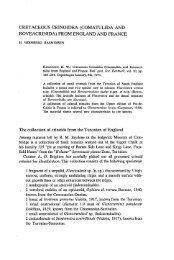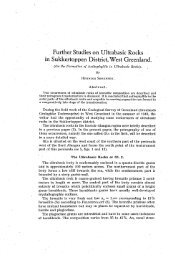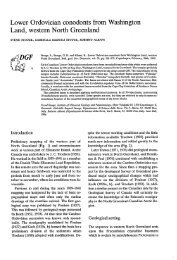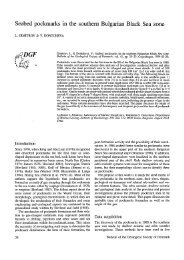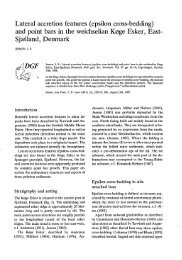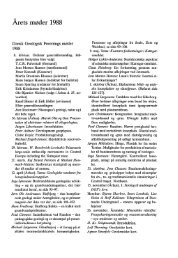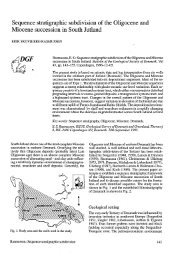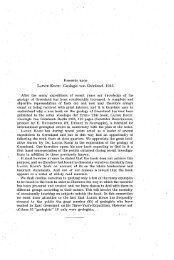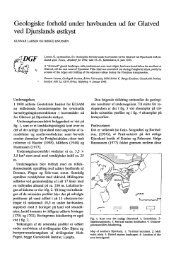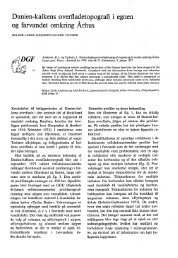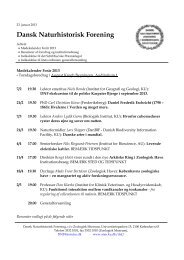Bulletin of the Geological Society of Denmark, Vol. 27/01-02, pp. 15-45
Bulletin of the Geological Society of Denmark, Vol. 27/01-02, pp. 15-45
Bulletin of the Geological Society of Denmark, Vol. 27/01-02, pp. 15-45
Create successful ePaper yourself
Turn your PDF publications into a flip-book with our unique Google optimized e-Paper software.
<strong>Bulletin</strong> <strong>of</strong> <strong>the</strong> <strong>Geological</strong> <strong>Society</strong> <strong>of</strong> <strong>Denmark</strong>, vol. <strong>27</strong> 1978 41<br />
water-level and <strong>the</strong> <strong>of</strong>fshore wind result in a minimum<br />
<strong>of</strong> morphological activity during <strong>the</strong> 24<br />
hours around 25/9.<br />
At 1840 26/9 <strong>the</strong> water-level is increasing, but<br />
<strong>the</strong>re is still <strong>of</strong>fshore wind (swell situation); as<br />
expected, <strong>the</strong> morphological activity is a weak,<br />
constructive adjustment <strong>of</strong> <strong>the</strong> pr<strong>of</strong>ile.<br />
During <strong>the</strong> night <strong>of</strong> <strong>27</strong>/9 <strong>the</strong> wind turns from N<br />
to E (onshore wind) and simultaneously <strong>the</strong> wind<br />
speed increases markedly - <strong>the</strong> water-level decreases<br />
slightly. At 1000 a markedly destructive<br />
pr<strong>of</strong>ile development is recorded and an insignificant<br />
transport in connection with <strong>the</strong> migrating<br />
bar. It deserves notice that <strong>the</strong> migration is slow<br />
at <strong>the</strong> beginning <strong>of</strong> <strong>the</strong> active periods, see also<br />
23/9 at 1400.<br />
Between 1000 and 1300 this development<br />
continues in consequence <strong>of</strong> increasing wind<br />
speed and water-level; <strong>the</strong> migration <strong>of</strong> <strong>the</strong> bar<br />
starts, however, and is relatively significant at <strong>the</strong><br />
time <strong>of</strong> measurement. At 1700 <strong>the</strong> adjustments <strong>of</strong><br />
<strong>the</strong> pr<strong>of</strong>ile are accomplished, as both wind speed<br />
and water-level have remained constant, but <strong>the</strong><br />
material budget in connection with <strong>the</strong> migration<br />
<strong>of</strong> <strong>the</strong> bar is almost <strong>the</strong> same. Until 1900 <strong>the</strong><br />
water-level is constantly, but slightly decreasing,<br />
whereas <strong>the</strong> wind speed has slowed down. The<br />
magnitude <strong>of</strong> migration is largely unchanged, but<br />
a constructive pr<strong>of</strong>ile development has started.<br />
This situation continues over night until 1000<br />
28/9, although with decreasing migration velocity.<br />
Again a repetition is observed on <strong>the</strong> development<br />
around <strong>the</strong> active period 23/9; <strong>the</strong> migration<br />
<strong>of</strong> <strong>the</strong> bar is at a minimum during <strong>the</strong><br />
constructive period.<br />
Between 1000 and 1400 <strong>the</strong> water-level rises<br />
significantly, whereas <strong>the</strong> wind speed is constant.<br />
This results in an increased destructive adjustment<br />
<strong>of</strong> <strong>the</strong> pr<strong>of</strong>ile, which was a<strong>pp</strong>arently at its<br />
maximum at <strong>the</strong> time <strong>of</strong> measurement.<br />
Until next measurement at 1600 29/9 both<br />
water-level and wind velocity decrease, and <strong>the</strong><br />
final constructive development <strong>of</strong> <strong>the</strong> pr<strong>of</strong>ile is<br />
accomplished (fig. 16).<br />
On <strong>the</strong> basis <strong>of</strong> <strong>the</strong> detailed observations it can<br />
be concluded that <strong>the</strong> material transport in <strong>the</strong><br />
investigation area must mainly be explained as<br />
pr<strong>of</strong>ile adjustments. The frequent measurements<br />
reveal that <strong>the</strong>y occur continuously and very rapidly.<br />
It is <strong>the</strong>refore important to stress that variations<br />
both in wind speeds, -directions and in<br />
water-levels are <strong>of</strong> great importance; fluctuations<br />
in <strong>the</strong>se parametres, both isolated and toge<strong>the</strong>r,<br />
induce a great morphological activity and a subsequent<br />
material transport.<br />
It must <strong>the</strong>refore be stressed that each<br />
measurement only represents <strong>the</strong> morphological<br />
development during <strong>the</strong> last few hours and that<br />
<strong>the</strong> calculated gross budgets will generally be too<br />
small when <strong>the</strong> intervals between measurements<br />
surpass a few hours. It is interesting to notice that<br />
<strong>the</strong> migration <strong>of</strong> <strong>the</strong> nearshore bar is a<strong>pp</strong>arently<br />
at a minimum when <strong>the</strong>re is a very active adjustment<br />
<strong>of</strong> <strong>the</strong> pr<strong>of</strong>ile.<br />
The main purpose <strong>of</strong> <strong>the</strong> volume calculations<br />
was to investigate whe<strong>the</strong>r <strong>the</strong> final phase <strong>of</strong> <strong>the</strong><br />
migrating nearshore bar, when it is joining <strong>the</strong><br />
foreshore, means a permanent contribution <strong>of</strong><br />
material to <strong>the</strong> beach. Of <strong>the</strong> observed two<br />
nearshore bars, <strong>the</strong> first one did not quite reach<br />
fusion with <strong>the</strong> foreshore because ano<strong>the</strong>r nearshore<br />
bar was formed far<strong>the</strong>r seaward, and at <strong>the</strong><br />
termination <strong>of</strong> <strong>the</strong> investigation <strong>the</strong> new bar had<br />
joined <strong>the</strong> first one (fig. 9j). If <strong>the</strong> migration <strong>of</strong><br />
<strong>the</strong> nearshore bar results in a su<strong>pp</strong>lement <strong>of</strong> material,<br />
this should be seen in fig. 16 from around<br />
1/11; just at this time <strong>the</strong>re is also a volume<br />
maximum. From a morphological viewpoint <strong>the</strong><br />
foreshore is only contributing to this accumulation<br />
<strong>of</strong> material on a small scale which — as later<br />
measurements showed — was not permanent. The<br />
development during <strong>the</strong> last part <strong>of</strong> <strong>the</strong> investigation<br />
(after 1/11 daily measurements were not<br />
taken) was a decrease in volume which was not<br />
obviously due to <strong>the</strong> dynamic conditions.<br />
A comparison between <strong>the</strong> two contour maps<br />
from 14/9 and 11/11 (figs 9a and 9j) reveals that<br />
during <strong>the</strong> observation period, <strong>the</strong> forms on <strong>the</strong><br />
inshore terrace were dislocated northwards. It<br />
was thus to be expected that cyclically determined<br />
volume variations with low values were to<br />
occur just when <strong>the</strong>! measurements were terminated.<br />
With regard to <strong>the</strong> total material budget for <strong>the</strong><br />
study period, table 3, it must be emphasized that<br />
<strong>the</strong> indicated (measured) gross value must be too<br />
small because <strong>of</strong> <strong>the</strong> great intervals between <strong>the</strong><br />
measurements; fur<strong>the</strong>rmore, that starting and final<br />
dates were chosen at random which has<br />
greatly influenced <strong>the</strong> net result. In spite <strong>of</strong> this, it<br />
is possible to get a picture <strong>of</strong> <strong>the</strong> magnitude <strong>of</strong><br />
material transport in <strong>the</strong> area and especially <strong>of</strong>



